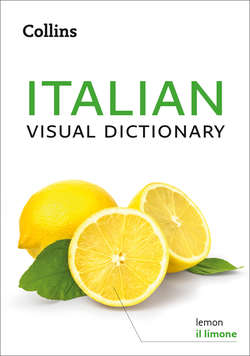Читать книгу Collins Italian Visual Dictionary - Collins Dictionaries - Страница 5
INTRODUCTION
ОглавлениеWhether you’re on holiday or staying in Italy for a slightly longer period of time, your Collins Visual Dictionary is designed to help you find exactly what you need, when you need it. With over a thousand clear and helpful images, you can quickly locate the vocabulary you are looking for.
The Visual Dictionary includes:
10 chapters arranged thematically, so that you can easily find what you need to suit the situation
images – illustrating essential items
YOU MIGHT SAY… – common phrases that you might want to use
YOU MIGHT HEAR… – common phrases that you might come across
VOCABULARY – common words that you might need
YOU SHOULD KNOW… – tips about local customs or etiquette
USING YOUR COLLINS VISUAL DICTIONARY
In order to make sure that the phrases and vocabulary in the Collins Visual Dictionary are presented in a way that’s clear and easy to understand, we have followed certain policies when translating:
1) The polite form “Lei” (you) has been used throughout the text as this is always safe to use, even if a bit formal at times, for example:
How are you? Come sta?
Remember that if you are addressing an older person or someone you have just met, you use “Lei”. However, if you are speaking to children, or those you know well, you can use “tu”. Italian people may invite you to use “tu” with them:
Shall we call each other “tu”? Diamoci del tu?
Note that personal pronouns (I, you and so on) are not usually used in Italian except for emphasis:
Sto bene. I’m well.
2) The grammatical gender of Italian nouns has been indicated using the articles “il” or “lo” (masculine) or “la” (feminine). All nouns which have the article “l’” have been shown with their gender, for example:
year l’anno m
exit l’uscita f
In many cases, particularly in words describing professions, the masculine form of the noun tends to be used for both men and women, even if the feminine form exists. In some cases, no feminine form exists at all, for example:
surgeon il chirurgo
Where the feminine form is commonly used, it has been shown after the masculine form of the noun:
vet il veterinario / la veterinaria
3) In general, the masculine form of adjectives only has been shown for vocabulary items and in phrases, for example:
bored annoiato
I’m allergic to… Sono allergico a…
However, in some cases both forms are shown:
I’m married. (man) Sono sposato.
I’m married. (woman) Sono sposata.
Remember that, in Italian, the adjective often changes depending on whether the noun it describes is masculine or feminine. Most masculine adjectives end in “-o” and feminine ones in “-a”, so with a feminine noun “contento” becomes “contenta” and “stanco” becomes “stanca”. Adjectives ending in “-e” like “felice” remain the same whether the noun they describe is masculine or feminine.
The adjective form also changes if you are talking about a person or object in the singular or in the plural. Usually, the plural form of the adjective is formed by adding “-i” (for masculine nouns) or “-e” (for feminine nouns) to the end of the word. Adjectives ending in “-e” form the plural with “-i”:
The girls are bored. Le ragazze sono annoiate.
We are happy. Siamo felici.
FREE AUDIO
We have created a free audio resource to help you learn and practise the Italian words for all of the images shown in this dictionary. The Italian words in each chapter are spoken by native speakers, giving you the opportunity to listen to each word twice and repeat it yourself. Download the audio from the website below to learn all of the vocabulary you need for communicating in Italian.
www.collinsdictionary.com/resources
